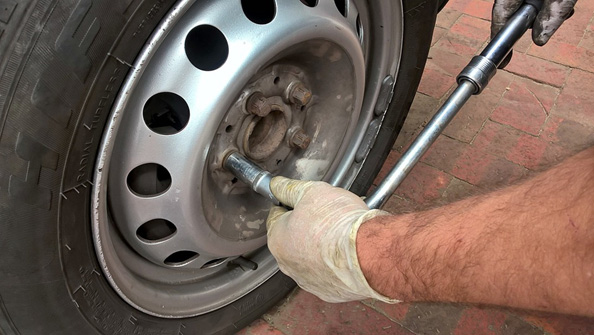HOW TO CHANGE A TYRE

Changing a tyre may seem like a daunting task, but it really isn’t so hard if you know what you are doing and take it slowly. You may find yourself in a situation where you suffer a puncture or other tyre damage and have no other option but to fit your spare tyre to your vehicle. So make sure you know how to change a tyre with our guide!
What You Need
You should make sure that you carry the following in your vehicle in case you need to change your tyre:
A spare tyre in useable condition. Check the condition, tread depth and tyre pressure of your spare before you need to use it. You should also regularly check it for signs of cracking, which can occur in older tyres
Your vehicle handbook which may contain advice on changing a tyre specific to your vehicle. You should read this information before you are in an emergency situation
A vehicle jack which will be located by your spare tyre. If you do not have this piece of equipment you can purchase one from a suitable retailer
Your locking wheel nut key which may be in the glove compartment or with your spare tyre
A wheel wrench which can be purchased from a suitable retailer if you do not have one in your vehicle
You should also consider packing a bag which includes a warning triangle, gloves, torch, and a plastic sheet
Wheel chocks (not essential but recommended for added safety)
Changing Your Tyre
Precautions
Although you may suffer a puncture or tyre damage at any time, you must ensure that you pull over somewhere safe and flat before attempting to change your tyre. Make sure that you park your vehicle somewhere that will not disrupt other motorists and set up a warning triangle 50 metres behind your vehicle.
When you are safely parked, switch on your hazard warning lights and put your handbrake on. Place your wheel chocks behind your tyres (if available), except for the one you are changing to prevent the car from rolling.
Changing the tyre
Before lifting your vehicle, loosen your wheel nuts between ¼ and ½ of a turn using the wrench and locking wheel nut key, applying weight to the bar and turning in an anti-clockwise direction.
Lift your vehicle using the jack. The right place for the vehicle jack is usually beneath the vehicle frame alongside the tyre you are changing, however, it is vital that you check your vehicle handbook for specific instructions to avoid damaging your vehicle. You can then jack your vehicle about 6 inches from the ground, again following the instructions in your vehicle handbook.
When your vehicle is raised, remove the wheel nuts all the way which you should be able to do by hand now they are loose. Take care to remove the damaged tyre from your vehicle, as they are heavier than you may think, and place it on the ground flat and out of the way, to prevent it from rolling away.
Lift and put your new wheel and tyre in place and tighten the wheel nuts so they are secure but not fully tightened. You can then lower your car, removing the jack as per the instructions in your handbook, and tighten the wheel nuts fully using your wheel wrench and locking wheel nut key.
When you are happy your new tyre is securely fitted, pack away all your equipment and the old tyre.
Follow-Up Actions
If you have fitted a space saver tyre to your vehicle you must drive as specified. Space savers are intended for only travelling short distances and at low speed, usually under 50 mph.
You should visit a tyre specialist as soon as possible to have your punctured tyre either repaired or replaced and the whole unit rebalanced and realigned.
Not all modern vehicles come with spare wheel and tyre combinations and you may need to use either an inflation unit or a pressurised container with sealant. Please ensure you are aware of what your vehicle is equipped with and follow the relevant instructions on the package or container.
For further guidance, contact your local Merityre Specialists where one of our trained technicians will be happy to offer more advice.